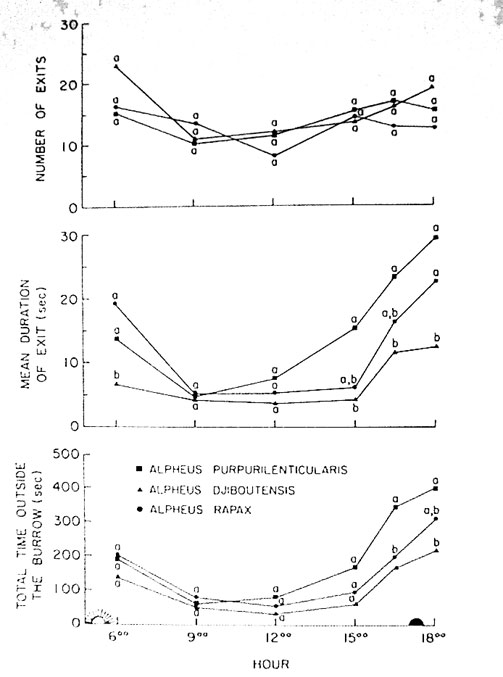





Daily Rhythm Patterns
Most organisms have some sort of daily activity pattern that makes the more active in the day (diurnal) or in the night hours (nocturnal). The shrimp and goby are no different. For every species studied to this date, activity begins with sunrise (or close to it), and ends at sunset when goby and shrimp retreat into the burrow and the burrow entrance collapses (Magnus 1967; Karplus et al 1972, 1974, 1976, 1979; Polunin and Lubbock 1977; and Yanagisawa 1982, 1984).
In the case of diurnal rhythms, the activity that has been mostly studied is the activity of the shrimp, whom does all the digging and burrow maintainence. With a great deal of the studies done on shrimp gobies, have come a good understanding of the activity rhythms and some general themes amoung species.

The first aspect of the rhythm is the amount of time spent outside the burrow by the shrimp (see above figures) (Karplus 1976). Shrimp spend about one-third of their time outside the burrows in the morning, reduce the time around noon and then spend the majority of time outside the burrow at night. These rhythms can be slightly effected by the tides too. When the water level reaches 3-5cm above the burrow, activity usually stops (Karplus 1976).
The activity that the shrimp performs while outside the burrow does change however. In the morning, the shrimp usually leave with their chelae full of sediment and in the afternoon they are usually empty. Also, most of the introduction of sediment, usually in the form of organic material for food usuage later, it introduced primarily in the afteroon. Finally, the amount of burrow construction activity, in the form of reinforcing the outer walls of the burrow, are mostly performed in the afteroon (Karplus 1976).
The activity of the shrimp begins and ends around surnrise and sunset respectively, however, not all individuals will begin at the same time. The start of activity takes place when a goby emerges from the sand, followed by the shrimp (Magnus 1967, Karplus 1974; Yanagisawa 1982, 1984). Its believed that the begining of activity is synchronized by some sort of endogenous rhythm, while the end of activity is usually synchronized by the light levels, and thus the later is more sychronized amoung individuals (Karplus 1976). Finally, activity varies amoung the sex of the shrimp. Most of the activity outside the burrow is initiated by the male shrimp (Yanagisawa 1982).